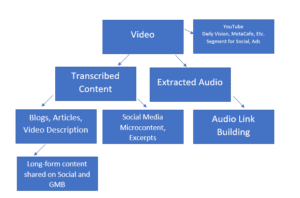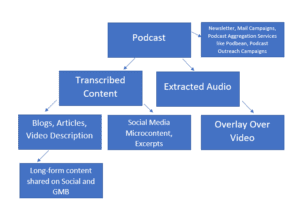Coming up with quality content is challenging. I can’t tell if this is going to be a quality blog just yet; but if we haven’t discussed this topic before, chances are high there will be a few takeaways. Repurposing content is the process of taking an in-depth and original piece of content on a medium such as a blog and transforming it into a different medium such as a video (visual, audio), webinar (visual, audio), or podcast (audio).
Extracting aspects of these media and using them for other kinds of content repurposes the original material. The new material can be distributed through unique channels, bringing increased life and accessibility to the work you’ve completed. Here, we’ll evaluate three types of media that generally make good use of repurposed content. From there, you can draw inspiration for repurposing other kinds of media with less reach, like blogs and articles.
Video
I always considered videos to be the ultimate piece of content for repurposing. You can transcribe the audio, distribute the visuals, and the visibility can span more channels than almost any other type of content. Videos also increase time on site, trustworthiness, and usually boost conversion rates. Below is what our video repurposing model looks like:
The first thing you want to do with any video, whether you have plans of hosting it or not, is to publish it on YouTube and optimize it. There’s no reason not to give your videos a little bit more exposure on the second-most popular search engine in the world. Other video hosting websites like DailyMotion may be worth submitting to for additional visibility without much more effort.
You want to take advantage of the three components of video: audio, visual, and the potential for content. To start with the content portion, we like Rev.com as a transcription service. You can also find a variety of transcription services on Fiverr. Keep in mind that many employ software like Dragon Diction or Google Docs, which attempt to do transcription automatically, and make a half-hearted attempt to edit it manually afterward. The best use of time is using a service that specializes in transcription by a human or at the very least, one that uses sophisticated transcription software and thoroughly edits it at the end by hand.
Additional opportunities for repurposing content and audio include creating a process for adding posts to Google My Business and using the audio for other link-building opportunities. Once your content is transcribed, you can feature it on a webpage alongside the corresponding video or use portions of the transcription to create more blogs and articles. This will save you considerable time from conceptualizing brand-new blog and article topics.
Portions of the transcribed content can also be used as “microcontent” on off-site platforms, namely social media. In our experience, every minute of video produces about 250 words of content. Some people have videos that only run 1-2 minutes each, yet this content adds up over time. By transcribing complementary topics together, you could create extensive articles and cover a variety of subjects on your website.
Webinar
Webinars are becoming increasingly popular for digital marketing agencies like ours, but there’s no reason other business owners can’t use them to educate their ideal clients. They can help just about anyone establish themselves as an authority on popular topics.
Reoptimizing content into a webinar follows a process similar to video; however, webinars are more useful for remarketing. Webinars can start by following the same repurposing process as videos but use different means by essentially putting the webinar in front of people who might have missed it the first time it was released or weren’t aware of it in the first place.
The most significant difference between webinars and videos when it comes to repurposing content is the fact that most people conduct webinars with PowerPoint presentations. This gives you extra opportunities to submit your presentation to websites that support them for a link back. Additionally, slides act like static images which could be used to support the content being repurposed on and off your website.
The most effective way to repurpose a webinar is to use it for remarketing. This compact, thorough content — which is usually no less than 30 minutes long — should have a useful lifespan of at least six months and as long as one year. Replays should be included in many of your online marketing initiatives, from your weekly or monthly newsletters, e-mail campaigns, and featured on your website. You can promote your webinar in its original form via paid campaigns on Facebook and LinkedIn, and other avenues.
Here is a link to Market My Market’s most recent webinar: https://youtu.be/xer564pXlxE.
Podcast
Since podcasts do not have a visual component, you can instead start by creating a visual component for podcasts and giving them a similar process to videos. You can use the audio from a podcast and drop it into a single frame using video production software. Then, you can post that as a video on YouTube. Surprisingly, YouTube is a frequent resource for accessing audio without visuals.
Similar to a webinar, you can promote podcasts through more of a remarketing route in addition to repurposing. Podcasts can also be easily transmitted to several platforms. You can get started through services like Podbean.
Make Every Word Count
Every great piece of content starts with a purpose and a vision. At Market My Market, quality content is at the core of every successful content strategy we’ve implemented for a variety of clients. Our specialized content marketing team conceptualizes blog and page ideas based on proven research methods to ensure content drives traffic and in turn, contributes to the growth of your business. We have many ways of stretching your content — and your marketing budget — to help you reach new heights. Request a free marketing consultation here.

The ongoing digital revolution is transforming the way that all businesses interact with clients and customers. Consumers rely heavily on digital channels for researching products and services and expect to make buying choices with the swipe of a finger. For organizations that want to remain competitive, having a defined digital marketing strategy and execution plan is essential for successful outcomes. With a demonstrated history of creating and implementing strategic digital marketing initiatives that drive growth, I am committed to delivering real, measurable results for my clients.





